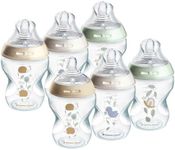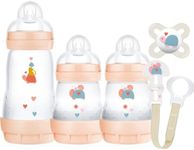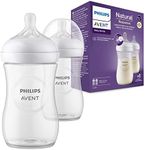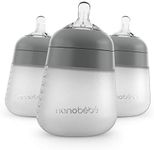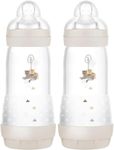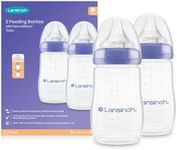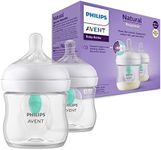Buying Guide for the Best New Baby Bottles For Breastfed Babies
Choosing the right baby bottle for a breastfed baby can be a crucial decision for parents who want to ensure a smooth transition between breastfeeding and bottle feeding. The goal is to find a bottle that mimics the breastfeeding experience as closely as possible to avoid nipple confusion and ensure the baby is comfortable. When selecting a baby bottle, consider factors such as the material, nipple shape, flow rate, and ease of cleaning. Each of these aspects can significantly impact your baby's feeding experience and your convenience as a parent.MaterialBaby bottles are typically made from plastic, glass, or silicone. The material is important because it affects the bottle's durability, weight, and safety. Plastic bottles are lightweight and shatterproof but may contain chemicals like BPA, so it's crucial to choose BPA-free options. Glass bottles are heavier and can break, but they are chemical-free and easy to clean. Silicone bottles are flexible and safe but can be more expensive. Consider your lifestyle and preferences when choosing the material; for instance, if you travel often, a lightweight plastic bottle might be more convenient.
Nipple ShapeThe nipple shape is crucial for breastfed babies as it should closely resemble the mother's breast to prevent nipple confusion. Nipples come in various shapes, such as standard, orthodontic, and wide-neck. Standard nipples are more traditional, while orthodontic nipples are designed to support oral development. Wide-neck nipples are often preferred for breastfed babies as they mimic the breast's shape more closely. Observe your baby's latch and feeding style to determine which shape might be most comfortable for them.
Flow RateFlow rate refers to how quickly milk flows from the bottle's nipple, and it's important because it needs to match your baby's feeding ability and age. Nipples come with different flow rates, such as slow, medium, and fast. Newborns and younger babies typically require a slow flow to mimic the natural breastfeeding pace and prevent choking. As your baby grows and becomes more efficient at feeding, you can transition to a medium or fast flow. Pay attention to your baby's cues; if they seem frustrated or take too long to feed, it might be time to adjust the flow rate.
Ease of CleaningEase of cleaning is an important consideration for maintaining hygiene and convenience. Bottles with fewer parts are generally easier to clean, while those with more components may require more effort to ensure all parts are sanitized. Some bottles are dishwasher safe, which can save time, but always check the manufacturer's instructions. Consider how much time you can dedicate to cleaning and whether you prefer hand washing or using a dishwasher when choosing a bottle.
Anti-Colic FeaturesAnti-colic features are designed to reduce the amount of air a baby swallows during feeding, which can help prevent gas and discomfort. These features often include venting systems or specially designed nipples. While not all babies experience colic, if your baby seems gassy or fussy after feeding, an anti-colic bottle might be beneficial. Evaluate your baby's feeding behavior and consult with your pediatrician if you're unsure whether these features are necessary.


